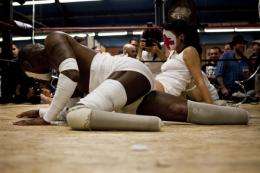Phantom limb formation relates to how sensory contact is lost

The phantom limbs perceived by many amputees and others who lose sensory connection with their bodies, do not form in “default” postures as often thought, but instead coalesce into positions that are dependent on experiences the limbs undergo while sensation is lost.
That’s suggested by researchers who strapped volunteers' hands to manipulative test devices and then cut off circulation to their arms. The team’s findings were published in a paper, Dynamic changes in the perceived posture of the hand during ischaemic anaesthesia of the arm, published last week in the Journal of Physiology.
To perform the phantom hand experiments, the researchers ringed volunteers' upper right arms with inflatable cuffs, screened off their right hands from view, and then applied heat and cold and used other sensory stimulation to determine when blocking the blood supply had done the trick. “About 30 min[utes] after inflation, voluntary movement was abolished for wrist and finger movements,” the team reported.
Although their right hands were deadened, the subjects felt certain of the positions of their hands – meaning the ghostly extremities had arrived. However, when they used their left hands to move a wooden artist’s dummy into the position that they felt their right hands were in, researchers found that far from the phantoms assuming a standard posture, a strange manner of variation was evident.
“Surprisingly, if the wrist and fingers are held straight during anaesthesia, the perceived phantom hand becomes bent at the wrist and fingers, but if they are bent during anaesthesia, the final phantom is extended at the wrist and fingers,” the study found.
Report co-author Lee Walsh from Neuroscience Research Australia said that the findings “go against some opinion in phantom literature that the phantom adopts a default posture, and if you look at a lot of amputee cases, you do see that there can be general patterns. For that reason, it’s often put that once sensory information goes away, you develop a phantom and that phantom develops a default posture – our results show that that’s probably not true.”
During the earlier period of cuff inflation and increasing paralysis, subjects also reported – at different stages – that their hands were in a series of positions, meaning that the phantoms had shifted. Furthermore, when the hands were fully paralysed and the volunteers had what their hands were doing in reality, they reported being able to move their hands.
“If subjects command their wrist to flex or extend, the phantom shifts its position in the direction of the intended movement … and the speed of this illusory movement grades with the level of subjective effort,” the study found. “This highlights the ease with which the ‘phantom’ hand is incorporated into the systems which plan and execute movement.”
Dr. Walsh said that phantoms are believed to form because the brain keeps maps, or representations, of the body. “Over time that is built up from sensory information but ultimately the brain holds onto these maps which it uses for various things like telling you where your arms and legs are and what happens when you remove the sensory information is that the brain has held onto that map.”
“Even though we cut off sensory information below the elbow, the brain still has a map that says below the elbow is an arm and a hand, four fingers and a thumb,” Dr. Walsh said. “What we think is happening is that the brain holds onto that map but certain things can still manipulate that map – certain things that don’t depend on sensory information. Or in this case, because the sensory information is removed slowly over time, we think the brain is actually interpreting that slow removal as a change in the position of the hand.”
“The position of the phantom might depend on the last sensory information the brain receives … that fading information may be telling the brain that the hand is changing information,” Dr. Walsh said.
While the current study was not clinically oriented, it did have relevance to clinical inquiries, Dr. Walsh said. “An amputee’s phantom limb can hurt quite a lot – but pain is just another sensory signal so from a clinical point of view there would be interest in whether you could manipulate sensation to help alleviate some of the symptoms, and there are other conditions that upset these body maps and representations that completely unrelated to amputations: strokes, for example, can upset how your perceive your body. It could help give us an understanding of how those maps develop.”
Dr. Walsh said that he has put himself through the test and can report that when the cuffs are deflated after 40 minutes, the pins and needles are not insignificant. “It takes about five minutes to recover, but it’s five minutes of very intense experience,” he said. “You have to experience it,” he added.
This story is published courtesy of the The Conversation (under Creative Commons-Attribution/No derivatives).

















